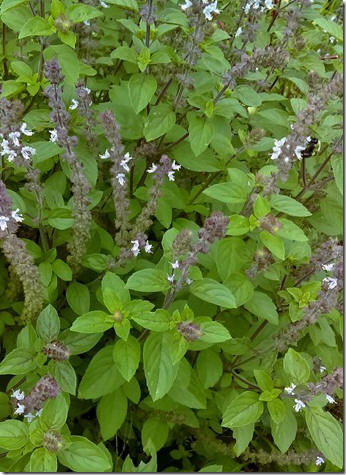|
In Praise of African Blue Basil
Martie Young
Adams County Master Gardener
 As I was wandering through my vegetable garden/weed patch I stopped at my large African Blue Basil (ABB) which was covered with carpenter bees, wasps, bumble bees, and other miscellaneous flying insects. Since one of my tasks as a master gardener is to count bees at our trial garden
in Gettysburg, I was thinking we should count the bees on this plant—but it’s not a native so it won’t be appropriate. I then considered how many gardeners actually know about this wonderful plant—perhaps you will want to put this plant on next year’s list of plants to try. Don’t buy your plants too early in the spring—June is the appropriate time to put them outside in
the soil—at the same time you plant your annual vinca plants. As I was wandering through my vegetable garden/weed patch I stopped at my large African Blue Basil (ABB) which was covered with carpenter bees, wasps, bumble bees, and other miscellaneous flying insects. Since one of my tasks as a master gardener is to count bees at our trial garden
in Gettysburg, I was thinking we should count the bees on this plant—but it’s not a native so it won’t be appropriate. I then considered how many gardeners actually know about this wonderful plant—perhaps you will want to put this plant on next year’s list of plants to try. Don’t buy your plants too early in the spring—June is the appropriate time to put them outside in
the soil—at the same time you plant your annual vinca plants.
 ABB is a lot different from other basils. Most members of the mint (Lamiaceae) family are perennial or annual herbs with square stems. The leaves are typically simple and oppositely arranged; most are fragrant and contain volatile oils. The flowers are
usually arranged in clusters and feature two-lipped, open-mouthed, tubular corollas (united petals) with five-lobed bell-like calyxes (united sepals). African blue basil has the botanical name of Ocimum kilimandscharicum x basilicum ‘Dark Opal’ and it was thought to originate in Kenya, Africa, and was discovered in the 1980s in an Ohio herb nursery. Because it is a hybrid
it doesn’t go to seed so all propagation is done by tip cuttings. Once you buy one plant, you can propagate as many as you want by taking cuttings all summer and early fall. ABB is a lot different from other basils. Most members of the mint (Lamiaceae) family are perennial or annual herbs with square stems. The leaves are typically simple and oppositely arranged; most are fragrant and contain volatile oils. The flowers are
usually arranged in clusters and feature two-lipped, open-mouthed, tubular corollas (united petals) with five-lobed bell-like calyxes (united sepals). African blue basil has the botanical name of Ocimum kilimandscharicum x basilicum ‘Dark Opal’ and it was thought to originate in Kenya, Africa, and was discovered in the 1980s in an Ohio herb nursery. Because it is a hybrid
it doesn’t go to seed so all propagation is done by tip cuttings. Once you buy one plant, you can propagate as many as you want by taking cuttings all summer and early fall.
If conditions are acceptable in your house, you may be able to winter over plants in a sunny window or under grow lights. Since no seeds are produced by ABB it can and does flower endlessly. Recalling all the other basil species, most people begin to pick off the flowers as soon as they appear because those basils are used for flavoring and
cooking. Allowing seeds to form affects the taste of the plant and slows down the growth of new stems. Not so with ABB—they just keep producing flowers all summer until the first frost—when they die in our zone (6b). ABB has a stronger camphor taste than other basils so many people don’t want to use it in cooking or flavoring. A suggestion for pesto is to mix various
basil varieties together for a more exotic flavor. The leaves are different from other basil species which have smooth very shiny bright green leaves. These leaves are a very dark green with maroon ribs and slightly fuzzy so if you do use the leaves it is suggested that they be cut very fine when used in salads or garnishes. The flower stems are dark purple and the actual
blossoms are light pink.
My main reason for growing ABB is for its flowers that bring the bees and other insects. It’s good to intermingle or use companion planting in veggie gardens. Plants need to be pollinated in order to form fruit or veggies—cucumbers, squash, tomatoes etc. and this system of companion planting keeps the bees in the vegetable garden and helps them
conserve energy by not having to fly as far to get back to their nests. Most bees (other than honey bees) are solitary and build their nests in hollow stems and in the soil. It’s good to keep a small patch of bare earth for the bees—not mulched ground but bare. You may see round holes in that ground—probably made by a carpenter bee—especially if you don’t have any wood
they can damage with holes. Bees also need water but a birdbath is sufficient.
ABB is a great example of a pollinator plant because all kinds of bees, moths, butterflies and other small flies and insects are attracted to the fragrant flowers—even in cloudy, cool weather you can find carpenter and bumble bees feeding on basil. When people wonder how they can help and encourage bees, the answer is to plant flowers-- in drifts
and clumps so bees don’t have to fly so far; combine flowers and veggies; interplant herbs in your foundation plantings; include herbs anywhere you have space. Another way to attract birds and insects to your gardens is to allow stems of Echinacea, Rudbeckia and other seed-producing perennials stand all winter to provide seeds and cover for birds.
To Propagate: (Use a 4-inch or similar pot with drainage holes and commercial potting mix)
- Once you have a healthy, sturdy ABB you can start taking cuttings to root in a glass jar of water. Choose a supple stem that’s purple or green with 4-8 leaf nodes (or more) that’s 6 to 10 inches long and make a cut a quarter inch below the bottom node. A leaf node is where a pair of leaves meets the stem, and it’s the point where new branches
will eventually sprout. Don’t pick a woody stem to root and don’t wait too long in the fall or too many branches will have become woody. The bottom 1-3 nodes will be under water, so use your fingernail or scissors to gently snip off the leaves and buds just around those nodes. The other leaves will continue to carry out photosynthesis and supply the cutting with
energy to grow roots.
- Put the cuttings in water, making sure that 1-3 inches of bare stems are submerged. Find a sunny spot for your jar and keep an eye on the cuttings. Remove any that die, keep the water level up, change the water if it becomes discolored, and wait for roots to grow.
- Once you have a lot of roots, it’s time to pot up the cuttings. Separate your cuttings gently. Put a couple inches of soil in the bottom of the pot. Rest the roots of a single cutting on top of the soil. Resist the urge to spread roots out—they will break or bruise. Gently sprinkle more soil on top of the roots until you fill the pot. Pack the
soil down with your fingers just a little bit to stabilize the cutting and water lightly.
- Over the next 1-2 weeks, keep your potted-up cutting in a semi-sunny spot outside. Water gently every other day or so. When you see lots of new growth or roots protruding from the drainage holes, the plants will be ready to transplant or give away.
Recipe:
Easy Pitcher Cocktail: Strawberry Basil Margaritas (one pitcher or about 8 servings)
- 1 can (12 ounces) frozen limeade concentrate
- 10 strawberries (sliced lengthwise)
- 8 basil leaves (try any flavor of basil)
- 2 to 2 1/2 cups tequila (gold or silver)
Empty the limeade concentrate into a pitcher. Add 2 1/2 cans of water and 1 1/2 to 2 1/4 cans of tequila.
Hull the strawberries, slice, and add to the pitcher. Crumple the basil a little in your hands to help basil flavor release into the drink and add to the pitcher. Place pitcher, covered, in the fridge over night or at least 4 hours.
Remove from fridge—drink should be a lovely pale pink.
Read other articles on birds, wildlife & beneficial insects
Read other articles on ecological gardening & native plants
Read other articles by Martie Young |